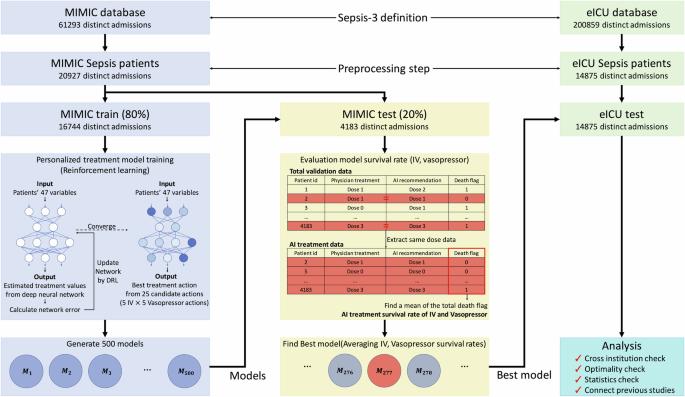Deep reinforcement learning extracts the optimal sepsis treatment policy from treatment records
IF 5.4
Q1 MEDICINE, RESEARCH & EXPERIMENTAL
引用次数: 0
Abstract
Sepsis is one of the most life-threatening medical conditions. Therefore, many clinical trials have been conducted to identify optimal treatment strategies for sepsis. However, finding reliable strategies remains challenging due to limited-scale clinical tests. Here we tried to extract the optimal sepsis treatment policy from accumulated treatment records. In this study, with our modified deep reinforcement learning algorithm, we stably generated a patient treatment artificial intelligence model. As training data, 16,744 distinct admissions in tertiary hospitals were used and tested with separate datasets. Model performance was tested by t test and visualization of estimated survival rates. We also analyze model behavior using the confusion matrix, important feature extraction by a random forest decision tree, and treatment behavior comparison to understand how our treatment model achieves high performance. Here we show that our treatment model’s policy achieves a significantly higher estimated survival rate (up to 10.03%). We also show that our models’ vasopressor treatment was quite different from that of physicians. Here, we identify that blood urea nitrogen, age, sequential organ failure assessment score, and shock index are the most different factors in dealing with sepsis patients between our model and physicians. Our results demonstrate that the patient treatment model can extract potential optimal sepsis treatment policy. We also extract core information about sepsis treatment by analyzing its policy. These results may not apply directly in clinical settings because they were only tested on a database. However, they are expected to serve as important guidelines for further research. Sepsis is one of the most life-threatening medical conditions. It can be challenging to select the best treatment strategy for individual patients. We developed a computational model to identify optimal treatment strategies and applied it to a large amount of data obtained from patients with sepsis. We identified particular types of information about the patients that can be used to decide on the best medication and dose to treat sepsis. Further development of our treatment model could potentially enable it to be used to improve the survival of patients with sepsis. Also, the results we obtained could be used to improve the general guidance followed when treating people with sepsis. Choi et al. develop and validate a sepsis treatment model based on deep reinforcement learning using patients’ treatment records. The model increases patients’ estimated survival rate and analysis of the treatment model’s strategies also suggests potential future sepsis research directions.

深度强化学习从治疗记录中提取最佳败血症治疗策略
败血症是最危及生命的病症之一。因此,许多临床试验都是为了确定败血症的最佳治疗策略。然而,由于临床试验的规模有限,找到可靠的治疗策略仍具有挑战性。在此,我们尝试从积累的治疗记录中提取最佳败血症治疗策略。在这项研究中,我们利用改进的深度强化学习算法,稳定地生成了一个患者治疗人工智能模型。作为训练数据,我们使用了三甲医院的 16744 份不同的入院记录,并用不同的数据集进行了测试。我们通过 t 检验和估算生存率的可视化来测试模型性能。我们还利用混淆矩阵、随机森林决策树的重要特征提取和治疗行为比较来分析模型行为,以了解我们的治疗模型是如何实现高性能的。在这里,我们展示了我们治疗模型的策略能显著提高估计存活率(高达 10.03%)。我们还表明,我们模型的血管加压疗法与医生的疗法大相径庭。在此,我们发现血尿素氮、年龄、器官功能衰竭顺序评估评分和休克指数是我们的模型与医生在处理败血症患者时差异最大的因素。我们的结果表明,患者治疗模型可以提取潜在的最佳败血症治疗政策。我们还通过分析脓毒症治疗政策提取了有关脓毒症治疗的核心信息。这些结果可能无法直接应用于临床,因为它们只在数据库中进行了测试。不过,它们有望成为进一步研究的重要指南。败血症是最危及生命的病症之一。为不同患者选择最佳治疗策略具有挑战性。我们开发了一个用于确定最佳治疗策略的计算模型,并将其应用于从败血症患者那里获得的大量数据。我们确定了患者的特定信息类型,可用于决定治疗败血症的最佳药物和剂量。进一步开发我们的治疗模型有可能使其用于提高败血症患者的生存率。此外,我们获得的结果还可用于改善治疗败血症患者时所遵循的一般指导。Choi 等人利用患者的治疗记录,开发并验证了基于深度强化学习的败血症治疗模型。该模型提高了患者的估计存活率,对治疗模型策略的分析还提出了未来潜在的败血症研究方向。
本文章由计算机程序翻译,如有差异,请以英文原文为准。
求助全文
约1分钟内获得全文
求助全文

 求助内容:
求助内容: 应助结果提醒方式:
应助结果提醒方式:


